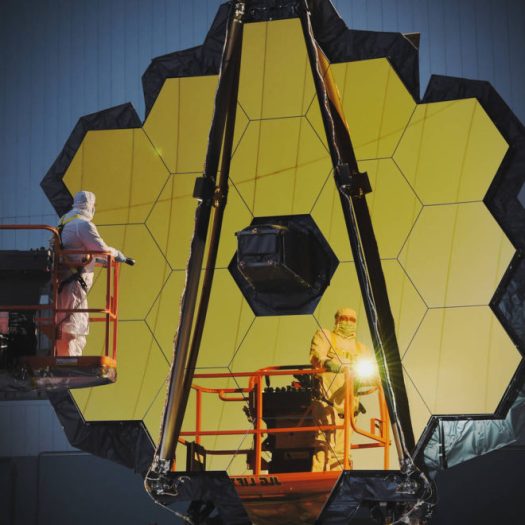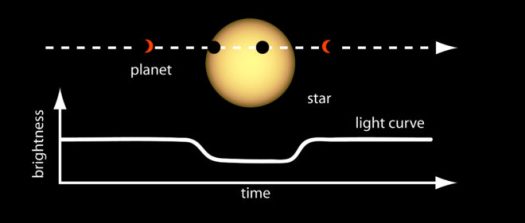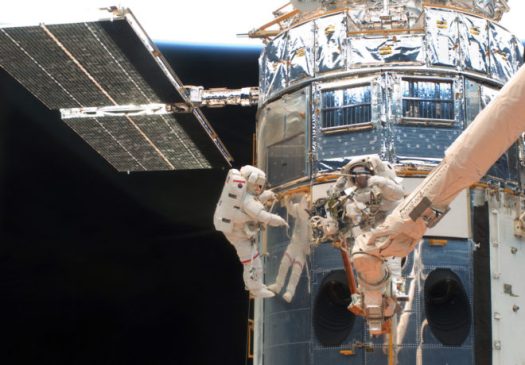
Recent word that the giant mirror of the James Webb Space Telescope is essentially complete is a cause for celebration, a milestone in the long march toward launching what will be the most powerful astronomical instrument ever. NASA Administrator Charlie Bolden made the announcement at the Goddard Space Flight Center, with senior project scientist John Mather declaring that “we’re opening up a whole new territory of astronomy.”
Although liftoff isn’t scheduled until two years from now, the mirror’s completion has led to an intensifying of the far less public but also essential task of determining how precisely the JWST will be used.
This is a major issue because the observatory will be far more complicated with many more moving parts for astronomers than the Hubble Space Telescope and other predecessors, and a significant amount of the learning about how to make observations can’t be done until JWST is already in space.
But more pressing still is the fact that “JW” (as it is now commonly called) will fly for a limited time, and as of now cannot be repaired or upgraded once in space because it will be too far away.
So while astronomers and the public have grown accustomed to long-lived observatories like the Hubble and Spitzer space telescopes — which have been revolutionizing astronomy for decades now — JW has a planned mission duration of just five years. Should the instruments continue working after that, the observatory will nonetheless run out of necessary fuel in 10 years.
Especially for exoplanet astronomers who often have to focus on a particular star and planet over a substantial time, this means they need to learn the JWST ropes fast or miss out on a scientific opportunity of a lifetime.
Natalie Batalha, a member of the JWST Science Advisory Committee and project scientist for the Kepler mission, said that the logic of the traditional proposal cycles and proprietary periods “threatens to stall the release of potentially important technical information keeping data out of the public domain until the five year nominal mission is well underway.”
“Because of the finite lifetime of JWST, we have an urgency here that we didn’t have with Hubble,” she told me.
“The JWST Science Advisory Committee recognized the need to get data into the hands of community scientists as early as possible to take full advantage of this so valuable but limited opportunity.”

The issue is doubly important because the four instruments flying on JWST all operate in a variety of modes and at a broad range of wavelengths. This makes understanding how to use the telescope and calibrate the data especially challenging.
To mitigate these problems, officials at the Space Telescope Science Institute (STScI) in Baltimore, which manages the JWST program, have agreed to set up an Early Release Science (ERS) program that will have no proprietary privileges and that will require researchers to share what they’ve learned with the community.
A limited but still significant 500 hours of JWST observation time will be given out of the Director’s Discretionary Time to the ERS. Those hours will be split among the main science communities that will use JWST — those studying the very early cosmos, the dynamics of galaxy formation and stars, and the worlds of exoplanets and objects in our solar system.
“It is one of the first programs of its kind,” said Kevin Stevenson, an European Space Agency/Aura astronomer at STScI and the lead author of a recent white paper on transiting exoplanet science that could be done as part of the ERS the program.
It will probably be the first program of its kind, said Kevin Stevenson, an European Space Agency/Aura astronomer at STScI and the lead author of a recent white paper on the program.

“As far as I know, an Early Release program like this has never been done before with other telescope programs,” he said.
Without the ERS program, researchers awarded JWST time in year 1 would have a proprietary period of 12 months after receiving their data, and they can use those results for Cycle (year) 2 proposals without anyone else having knowledge of how the telescope behaved for them.
“This creates a very unfair playing field for the rest of the community, which wouldn’t have that first year data until well into the second year — meaning they can make strong proposals only for (year) 3, when the nominal mission is half over.”
Under this Early Release Science program, the researchers have no proprietary rights to data and so must share everything promptly. “The goal is to do what’s good for the community and allow many researchers to have the information they need to make a strong case for JWST time,” Stevenson explained.
One consequence of the Early Release logic is that selected projects will most likely focus on easy to acquire, low-hanging fruit. The ERS program will intentionally focus on providing essential and representative data for the community rather than aiming for scientific breakthroughs — although who ever knows where important surprises may be hiding.
While the Early Release program is important and novel, it remains quite small compared to standard calls for observing time that will also be in place.
Guaranteed time for researchers — who have often worked for years developing JW instruments– will account for about 1,500 hours during the first year of observing, and 5,500 hours will go to researchers whose proposals are selected by JWST peer review panels.
While these researchers will be under no obligation to share their data for those substantial periods, efforts are underway to encourage sharing of what they learn about the operations of the telescope and instruments in particular because of the relatively short time JWST will operate.

JWST was conceived and largely designed before the detection of the first exoplanet in 1996 and as a result many of the observatory’s goals and capabilities lie elsewhere. Still, some modifications have been made to the original plans, and new insights into how exoplanet researchers can use the telescope and its instruments have led to great excitement and anticipation.
While the Hubble mostly observes in optical wavelengths with some infrared, JWST is primarily an infrared telescope and will be able to detect radiation emitted at much longer wavelengths.
In practical terms for exoplanet exploration, that means the instruments are expected to detect important compounds from methane to ammonia, sulfur dioxide and onward to larger carbon-based molecules, all of which have been challenging to identify so far. Using the fact that infrared radiation contains and transmits heat energy, the telescope should be able to see through the thick hazes and clouds that surround many exoplanets so its instruments can characterize the atmospheres and planets below based on thermal emissions.
Some researchers are convinced that JWST will be able to directly image some larger exoplanets — meaning that it will be able to collect and read the spectra of the atmospheres whether the planets are transiting or not.
Sasha Hinkley, an astrophysicist and expert in infrared instrumentation at the University of Exeter, said he is convinced JWST direct imaging of exoplanets is feasible and indicated he will propose an Early Release observation with that in mind (they’re due next August.) With direct imaging, he said, JWST could not only identify important compounds, but could also quite possibly identify “weather” on exoplanets.
“JW is just so versatile, and has so many bells and whistles,” he said. “This will allow for breakthrough science, but will also take valuable time to master. I think the community would really benefit if some of the early learning involved direct imaging.”
Stevenson has a somewhat different perspective. The white paper he authored was based on a workshop for scientists eager to work with JWST, and the recommendation in the paper was to focus on transits of large and well-defined planets, and most preferably the gas giant planet WASP-62b.

But all involved agree that research communities should put forward a small number of proposals with broad community input for the Early Release Science Program. This is in keeping with the goals of NASA’s Nexus for Exoplanet System Science, or NExSS, a research coordination network established to catalyze interdisciplinary and community collaboration. NExSS recently initiated a working group to draft a small number of ERS proposals to do transiting exoplanet science.
The STScI has also addressed the question of the observatory’s relatively short lifetime by commissioning development of a number of simulators to help guide scientists as they decide which planets and stars to explore, and in which observing modes to do it. These tools use known exoplanet and host star characteristics, combined with the most current knowledge of how the JWST instruments behave, to help simulate what the observations will look like through the eyes of JWST.
Substantial effort by STScI is being put into the simulators, the main one called the JWST Exposure Time Calculator (Pandeia) and the exoplanet equivalent (PandExo). Natasha Batalha, a graduate student at the Pennsylvania State University, has led the exoplanet simulator effort out of the Goddard Space Flight Center.
“PandExo will help researchers decide which JWST observing modes are best suited for the science they want to carry out. It will also help them to pin down exactly how many transits they need to observe to attain their desired level of precision, ” she said. “All of this information will be a crucial part of each researcher’s observing proposal.”
This ability is important when proposing observations of large planets but even more so with the smaller ones — the super Earths and sub-Neptunes. Because those planets will require many more transit measurements, Batalha said it’s crucial to determine how much observing time is needed to get a handle on whether the proposals are feasible.

It is because JWST is primarily an infrared telescope that it will be sent to an area about one million miles away, the second Sun-Earth Lagrange Point. That’s a gravitationally stable location where the observatory’s sunshade will always face the sun, and consequently defect most of the heat energy coming its way. This is essential since the telescope needs temperatures around -370 Fahrenheit to operate properly.
In contrast, the Hubble is in low-Earth orbit, about 375 miles away from home. The difference in locations explains why the Hubble has been serviced by astronauts five times, while current plans discount the possibility ever having humans fly to JWST to fix or upgrade it. NASA doesn’t now have the capability to send astronauts there, and if it did the mission would be enormously expensive.
So the astronomy community is left with this reality: The most powerful and potentially important telescope ever developed will have a relatively short working lifetime, as major space observatories go. And that’s why planning now for how it will be used during that window of time is so pressing.
